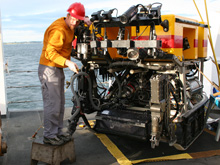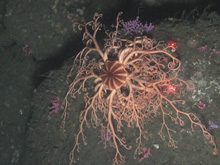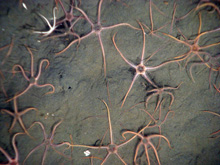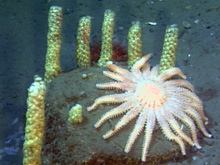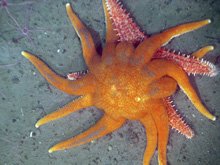Curt Whitmire with NOAA Fisheries was one of the scientisst on board the OCNMS cruise. Curt is 6ft tall and standing atop a stool, which gives you an idea of the size of the ROPOS ROV. Curt is adjusting the lasers that aid us in determining our field of view and the size of objects on the video screen. Click image for larger view and image credit.
Sea Stars in the Twilight Zone
May 26, 2006
Peter Etnoyer
Harte Research Institute
One of the interesting things about this expedition is that we used a remotely operated vehicle (ROV) to explore a deep-water middle-region called the “Twilight Zone” (Pyle 1996). To marine biologists, the Twilight Zone (TZ) is more than just a strange place, it represents a gap in our scientific understanding. Living benthic communities at these middle depths have been often overlooked, because they are too deep for scuba divers to investigate, yet poorly explored by ROVs and manned submersibles.
On this cruise, we explored the lower limits of the TZ with the ROPOS ROV to characterize the seafloor 100-1000m deep. Our deepest dive on this research cruise went to about 650m. ROPOS is one of the most capable scientific ROVs and crews I ever had the pleasure to accompany. The captain and crew of the NOAA Ship McArthur II are also talented and experienced. These crews work closely to navigate the underwater topography of our target habitats.
ROPOS is about the size of your typical SUV, but the wheels are replaced by small rotating jets like propellers. She descends on a long, thick, yellow fiber-optic tether drawn from a large 8-foot diameter spool fastened to the rear deck. In the video room, we see what ROPOS sees in real time, while working 12-hour shifts as the robot descends and traverses, recording biological observations along its path. On our cruise, the ROPOS and its crew actually broke their prior dive-endurance record, running underwater 52 hours straight through two nighttime surveys. The science party changed shifts three times before leaving the dive site.
Besides corals and fish, echinoderms are some of the most conspicuous characters on the deep seafloor. Sometimes they can be pretty exciting, for example when you’re on the edge of your seat hovering over a giant basket star (Gorgonocephalus) straining plankton from the water column, or watching thousands of brittle stars (ophiuroids) carpet the seafloor. However at other times, documenting echinoderms can be dull, like driving a car at night through the desert, watching the same species of sea cucumber (holothurian) or sea urchin (echinoid) re-appear over and over again for a kilometer or more.
Echinoderms are exclusively marine. Perhaps the best known echinoderms are the classic multi-armed forms we know as Asteroids, or sea stars. Asteroids can be fearsome predators. In rocky intertidal ecosystems, Pisaster ochracues seastars are keystone predators (Paine 1969) that regulate the abundance and distribution of nearshore mussels. In shallow coral-reef ecosystems, swarms of Acanthaster planci can devastate large swaths of reef.
Interestingly, some of the asteroids here in the Twilight Zone (e.g. the sunflower star Pycnopodia sp., sun star Solaster sp., and blood star Henricia sp.) are also found in the shallow intertidal zone. We don’t know whether they travel between intertidal and deep-sea habitats, but we do know they are capable of doing so. The giant Pycnopodia helianthoides can reportedly travel a mile in two days.
We covered a lot of sea-star territory on this cruise. So far, the abundance and richness of deep asteroids along the Olympic Coast seem relatively high. We’ve photographed many species in the Sanctuary and we’ve witnessed at least two antagonistic interactions of sea stars - Solaster dawsoni - attacking Hippasteriaspinosa and the avoidance reaction of the brittle star Ophiura sarsi to Luidia foliolata. We also documented one instance of presumed predation on molluscan egg towers by Pycnopodia. We believe deep-sea sea stars will make a good subject for further investigations, due to their ubiquity, diversity, obvious predation effects, and ease of collection.
References and further reading:
Etnoyer, P. 2006. "Sea Stars on the Fourth of July." Deep Sea News. July 3, 2006. http://deepseanews.blogspot.com/2006/07/sea-stars-on-fourth-of-july.html
Paine, R. T. 1969. "The Pisaster–Tegula interaction: prey patches, predator food preference, and intertidal community structure." Ecology 50:950–961.
Pyle, R.L. 1996. "How much coral reef biodiversity are we missing?" Global biodiversity 6(1):3-7 (Published in both English and French versions).
Pyle, R.L. 1996. "The Twilight Zone." Natural History 105(11):59-62.














